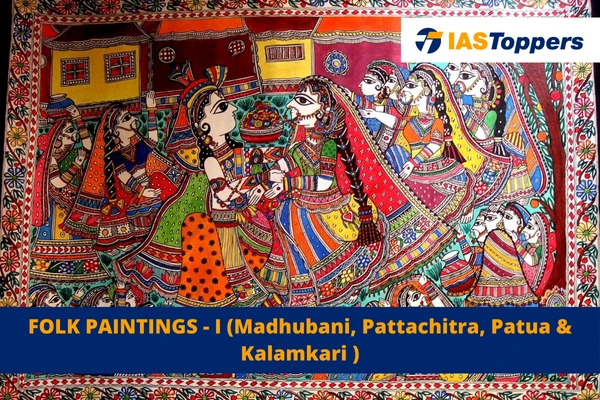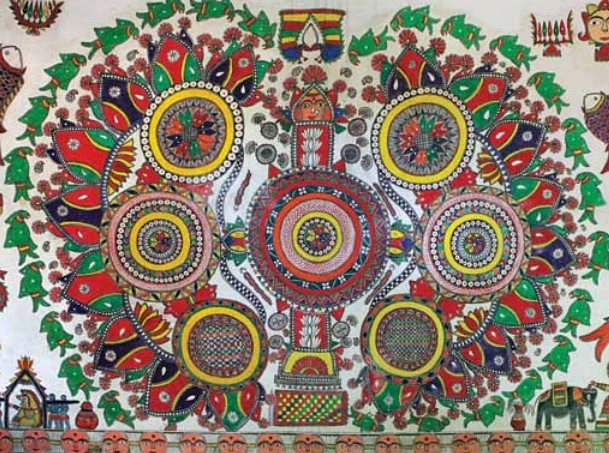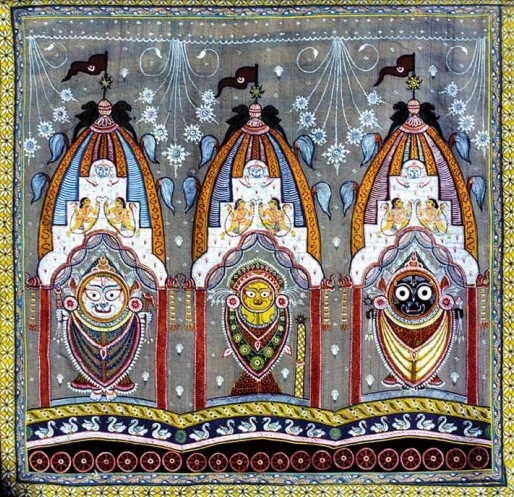Madhubani Paintings, Pattachitra Art, Patau Art, and Kalamkari Paintings are all important forms of Indian folk art, each with distinct regional origins and stylistic features. Madhubani paintings are known for their religious motifs and detailed linework from Bihar, while Pattachitra Art showcases intricate scroll paintings on cloth from Odisha. Patau Art, from Bengal, uses visual storytelling to bring traditional narratives to life on scrolls, and Kalamkari Paintings from Andhra Pradesh feature detailed fabric art using vegetable dyes, often showcasing stories from Hindu mythology. In this article, you will know meaning and definition of Madhubani, Pattachitra, Patua and Kalamkari painting and its key features, all of which are important for GS Paper-1 Art & Culture of UPSC IAS Exam.
Table of Content
- Madhubani Paintings: Bihar’s Folk Painting
- Pattachitra Art: Odisha’s Folk Painting
- Patau Art: Folk Painting
- Kalamkari Paintings
- Conclusion
- FAQs on Indian Folk Paintings
Madhubani Paintings
- Madhubani style of folk painting is originally crafted by village women in the vicinity of Madhubani town in Bihar.
- Also known as Mithila Paintings, the history and origins of Madhubani paintings can be traced back to the Ramayana era when the King of Mithila instructed his subjects to decorate their homes’ walls and floors for Sita and Rama’s wedding.
- The ancient region of ‘Mithilanchal,’ was ruled by King Janak and is considered the birthplace of Sita.
- References to Mithila painting can be found in Banabhatta’s Harshacharita.
- The art form can be traced back to the Harappa and Mohenjodaro period.
- It has been traditionally passed down through generations, mainly by women.
- In 1970, the President of India recognized Jagdamba Devi for her contributions to this art form.
- Other renowned Madhubani painters include Baua Devi, Bharti Dayal, Ganga Devi, Mahasundari Devi, and Sita Devi.
- Mithila painting consists of four types: Rangachitra (multi-coloured), Rekhachitra (line painting), Godna (tattoo painting), and Tantric painting (typically featuring figures accompanied by yantras).
- Due to its confinement to a specific geographical region, Madhubani painting has been granted geographical indication (GI) status.
Key features of Madhubani Paintings style of folk painting
- Madhubani Paintings typically have religious motifs from Hinduism, such as Radha-Krishna, Rama-Sita, Maa Durga, Sun, Lakshmi, Ganesha, Saraswati, Buddha and Shiva-Parvati.
- Some of the famous Madhubani paintings are based on Dashavatar (ten incarnations of Vishnu), Solah Sanskara for women and Solah Sanskara for men; episodes from Mahabharata and Ramayana etc.
- The presence of nature in Madhubani Paintings, including animals and birds such as peacock, flowers, and trees, is also prominent, often filling any remaining space in the composition.
- The figures of Mahbubani painting carry symbolic meanings, like fish representing good fortune and fertility.
- It depicts significant events like births, marriages, and festivals, with flowers, trees, and animals filling any empty spaces.
- In the past, artists used rice paste and vegetable colors on a base of cow dung and mud to create these paintings on walls. Over time, the medium shifted to handmade paper, cloth, and canvas.
- The artwork is two-dimensional, as there is no shading, and common characteristics include double line borders, vibrant colors, intricate floral designs, and exaggerated facial features.
- One of the significant themes in Mithila painting is kohabara, which refers to the main area of the house where these paintings are created.
- This area, known as the kohabara ghar, is a room specifically prepared for the groom to stay at his in-laws’ place after the wedding.
- In the Madhubani art culture, ceremonial paintings known as the Kohbar or the Puren were traditionally created in the ‘kohbar ghar’ – the bridal suite where the newlyweds would consummate their marriage.
Pattachitra Art

- Pattachitra style of folk painting is a cloth- based (cotton and tussar) scroll painting of Odisha.
- Pattachitra is a classic form of painting that combines elements of both classical and folk styles.
- The term “Pattachitra” is derived from the Sanskrit words “patta,” meaning cloth or canvas, and “chitra” which translates to picture or image.
- These paintings are mainly done by the Mahapatras and Moharana caste communities.
- Apart from Raghurajpur, there are several centres of this art at Parlakhemundi, Champamal (Sonepur), Athgarh and Dinabandhupur (Dhenkanal).
Key features of Pattachitra style of folk painting
- The Simple Pattachitra style of folk painting arecharacterized by their intricate details and vibrant colors, which are sourced from natural materials such as burnt coconut shells, hingula, ramaraja, and lamp black.
- The Patachitra art form from Odisha is officially recognized as Orissa Pattachitra, whereas the West Bengal variant is documented as Bengal Patachitra.
- The themes of Pattachitra paintings are deeply rooted in Hindu mythology, particularly drawing inspiration from the Jagannath and Vaishnava sects.
- Occasionally, the Shakti and Shaiva cults also serve as sources of inspiration.
- It is closely associated with the temple traditions in Puri.
- The community of these painters, referred to as chitrakarsati, is situated near the central temple.
- Heritage village of Raghurajpur in Odisha is renowned for its Pattachitra artists.
- These paintings bear a striking resemblance to the ancient murals found in Puri and Konark, and when executed on palm leaves, they are referred to as “talapattachitra.”
- Using white or black ink, hard dried leaves of palm trees are sewn together as a canvas on which images are drawn.
Famous Key themes of Pattachitra Paintings
- Thia Badhia (representation of the Jagannath temple),
- Krishna Rasa Leela (Jagannath as Krishna showing his childhood feats),
- Vastra Haran
- Dasabatara Patti (the ten incarnations of Vishnu),
- Nabagunjara (a figure comprising of nine different creatures),
- Kanchi Abhijana (expedition against the kingdom of Kanchi),
- Ganjpa (Playing cards),
- Panchamukhi (Five-headed Ganesh and Lord Hanuman),
- Kaliya Dalan Vesha (Krishna representing Sri Jagannath)
- Nava Grahas (Nine Planets),
How Pattachitra Paintings are prepared?
- First, a coating of delicate white stone powder and adhesive derived from tamarind seeds is prepared.
- The initial step involves creating the initial outlines in red or yellow (also sometimes white and black) using brushes.
- The colors used are organic and sourced locally, with black obtained from lamp soot, yellow and red from haritali and hingal stones, respectively, and white from ground conch shells.
- Subsequently, they fill in the colors and adorn the background with floral and foliage patterns.
- To complete the artwork, artwork is exposed to charcoal fire and a lacquer coating is applied, giving the painting a glossy finish.
Patau Art
- Originating from Bengal, the Patua style of folk painting carries a legacy spanning over a millennium.
- Initially, it was a folk tradition, where visual storytellers would narrate Mangal Kavyas – tales of reverence and wonder revolving around Hindu deities.
- The narratives are visually brought to life on scrolls, traditionally known as ‘pats’.
- The artists, known as ‘patuas,’ have passed down this unique storytelling method for centuries.
- The Patuas or chitrakars predominantly hail from regions such as Medinipur, Murshidabad, along with the North and South 24 Parganas, and the Birbhum districts.
- The majority of these Patuas are of Muslim faith.
- The patuas have a revered position within the Santhal community, similar to priests.
- They play a crucial role during significant life events such as births, deaths, and marriages, and are offered prayers and offerings.
- They travel from village to village, showcasing their painted scrolls while narrating folktales.
- In the past, these paintings were illustrated on fabric and largely focused on religious tales.
- However, modern adaptations of the art form utilize poster colors on interconnected paper sheets, serving as a medium to express views on contemporary political and societal issues.
- Patua scrolls depict traditional stories from epic texts like the Puranas, Ramayana, and Mahabharata, as well as local traditions such as the worship of the snake goddess Manasa or the renowned Bengali Vaishnava saint Sri Chaitanya. They also explore secular themes.
Jadupatua style of folk painting
- The Jadupatua style of folk painting of the Santhal tribes are vertical scroll paintings that were traditionally done on fabric but now shifted to paper mediums.
- The term ‘Jadupatua’ derives from ‘Jadu’, refers to the community that creates these paintings, and ‘Pat’, denoting the scroll used as their canvas.
- These painting were popular in Murshidabad, Birbhum, Bankura, Hooghly, Burdwan, and Midnapore districts of West Bengal, Jharkhand and Santal Parganas of Bihar.
Kalamkari Paintings
- Kalamkari style of folk painting originates from the use of a pen, or ‘kalam,’ crafted from sharp bamboo, which controls the colour. The ‘Kari’ means artistic work.
- It is painted on cotton fabric using vegetable dyes.
- They are either hand-painted or block-printed cotton textile produced in Isfahan, Iran, and in States of Andhra Pradesh and Telangana of India.
- The pen is prepared by immersing it in a blend of fermented jaggery and water before the dyes are used.
- Srikalahasti and Machilipatnam in Andhra Pradesh are the primary hubs of this art form.
- The practice of Kalamkari painting dates back to the Vijayanagara empire.
- The Kalamkari art and painting holds a geographical indication (GI) status.
- Painted or printed fabrics trace back to the Indus Valley Civilization.
- French traveller, Francois Bernier, noted the art’s historic popularity in his writings.
- The Mughal era, particularly the 16th and 17th centuries, saw this art form thrive, with creations such as kanat or prayer mat covers.
- Kalam Patua is a modern practitioner of Kalighat painting.
- Born into the Patua community, known for its tradition of scroll painting and storytelling, he self-taught the Kalighat style. This style incorporates elements from West Bengal scrolls and Indian miniature painting.
Key Features of Kalamkari style of folk painting
- Kalamkari style of folk painting, unlike other traditional fabric paintings like Pichhvais of Nathadwara or Mata ni Pachedi of Gujarat, incorporate a wider range of themes and figures.
- The designs, drawn freehand, often derive their inspiration from Hindu mythology.
- There are 2 styles of Kalamkari art in India: Srikalahasti style and the Machilipatnam style.
- Srikalahasti’s Kalamkari paintings often illustrate scenes from the Ramayana and Mahabharata, complete with written narratives.
- Kalahasti’s style of folk painting is defined by bold, black, angular lines, taking inspiration from temple murals, such as those found in the Veerabhadraswamy temple.
- Kalamkari traditionally portrays significant epics like the Ramayana or Mahabharata. However, in recent years, various figures including musical instruments, animals like peacock, flowers, Buddha, and some Hindu symbols like the swastika have been integrated into Kalamkari.
- Nowadays, conventional methods have given way to digital techniques. These modern kalamkari painting approaches have allowed for the introduction of digital Kalamkari, which are extensively prevalent in regions of India and Iran.
Conclusion
Indian Folk Paintings carry a distinct identity and a deep history, carrying the rich cultural heritage of their respective regions. They not only adorn walls but also narrate stories, capture traditions, and express societal changes. To protect these art forms from fading into obscurity, the Indian government should intensify its efforts to document, promote, and provide sustained patronage to these art forms. A national awareness campaign showcasing these unique art forms, along with providing financial support and training for the artists, would go a long way in preserving these invaluable cultural treasures.
Ref:
FAQs(frequently asked question)
What is Madhubani painting?
Madhubani painting is a traditional Indian art form from the Madhubani district of Bihar, known for its vibrant colors and religious motifs primarily depicting Hindu deities, natural elements, and significant life events.
Kalamkari painting belongs to which state?
Kalamkari painting is a traditional Indian art form, primarily originating from Andhra Pradesh and Telangana, characterized by its intricate hand-painted or block-printed designs on cotton textiles, often using vegetable dyes.
What is unique about Patua Art?
Patua Art is a unique visual storytelling tradition from Bengal, where narratives are brought to life on scrolls, traditionally known as ‘pats.’ The art form reflects both religious tales and contemporary societal issues.






